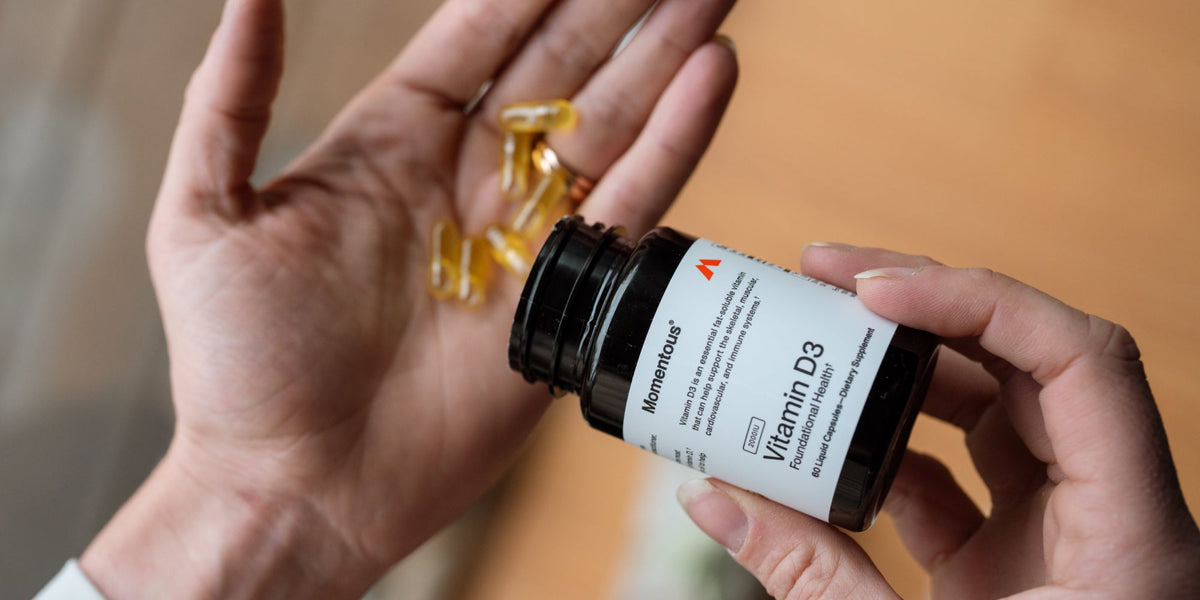
Factors That Impair or Enhance Nutrient Uptake
|
|
When it comes to supplementation, what you take is only half of the equation. How your body absorbs and utilizes nutrients is equally important. Even the most precisely formulated supplement is only as effective as its bioavailability, the proportion of a nutrient that is absorbed and used by the body. This is why the Momentous Women’s Three, which includes Iron+, Calcium (as calcium dimalate), and Vitamin D3, is formulated based on established principles of nutrient interaction and absorption physiology.
This article outlines the key physiological and lifestyle factors that influence nutrient absorption and how to strategically leverage them for optimal results.
Enhancers of Iron Absorption:
Vitamin C (ascorbic acid) reduces ferric iron (Fe³⁺) to its ferrous form (Fe²⁺), enhancing intestinal uptake via divalent metal transporter 1 (DMT1) located in the duodenum (Hallberg, Brune, & Rossander, 1989).
Fasted State intake has been shown to increase non-heme iron absorption by minimizing competition from other dietary components (Cook & Monsen, 1976).
Circadian Regulation of Hepcidin is critical. Hepcidin, a liver-derived peptide hormone that downregulates iron absorption, follows a circadian pattern and tends to be lower in the morning, which facilitates greater iron uptake (Ganz, 2011).
The Iron+ formula includes iron bisglycinate, a chelated form associated with better gastrointestinal tolerance and superior absorption. It is combined with vitamin C and B-complex vitamins, which support erythropoiesis, methylation, and cellular energy metabolism.
Inhibitors of Iron Absorption:
Calcium competes with iron at DMT1 and ferroportin transporter sites, even at moderate intake levels (Hallberg & Rossander, 1976).
Polyphenols and Tannins in beverages such as tea, coffee, and red wine bind iron in the gut and form insoluble complexes that impair absorption (Samman et al., 2001).
Phytates and Oxalates, found in whole grains, legumes, and leafy greens, chelate iron to form insoluble compounds (Hurrell et al., 2003).
Practical Application: Take Iron+ in the morning on an empty stomach or with a source of vitamin C (already in the Momentous Iron+ formula). Avoid concurrent intake with calcium, coffee, tea, or high-fiber meals.
Enhancers of Calcium Absorption:
Vitamin D3 (Cholecalciferol) increases the expression of intestinal calcium transport proteins such as calbindin-D9k and TRPV6, which enhance calcium uptake (Christakos et al., 2011).
Evening intake may be beneficial because bone remodeling and calcium incorporation into bone matrices are more active at night (Eastell & Hannon, 2008).
Calcium dimalate does not rely on gastric acid for solubility, which makes it suitable for older adults, or individuals on acid-reducing medications (Heaney, 2001).
Inhibitors of Calcium Absorption:
High Sodium Intake can lead to increased urinary calcium excretion through natriuretic mechanisms in the kidney (Massey & Whiting, 1996).
Oxalates, present in spinach, rhubarb, and beet greens, bind calcium and reduce its absorption in the intestine (Weaver & Heaney, 2001).
Simultaneous Iron Supplementation interferes with calcium uptake due to shared intestinal transport pathways (Gleerup et al., 1995).
Practical Application: Take calcium in the evening, ideally with vitamin D3, and space it at least 4 to 6 hours apart from Iron+ for optimal absorption.
Enhancers of Vitamin D Absorption:
Fat Intake improves absorption by promoting micelle formation, necessary for transporting fat-soluble vitamins through the intestinal lumen (Mulligan & Licata, 2010).
Magnesium acts as a cofactor for hepatic enzymes required for the conversion of vitamin D into its biologically active form, calcitriol (Uwitonze & Razzaque, 2018).
Calcium Co-ingestion is synergistic, as vitamin D enhances calcium absorption, and calcium provides the substrate for bone mineralization (Bikle, 2020).
The Women’s Three includes cholecalciferol (D3) form pair with a fat source, which has been shown to be more effective than ergocalciferol (D2) in elevating serum 25(OH)D concentrations and maintaining them over time (Trang et al., 1998).
Inhibitors of Vitamin D Activity:
Fat Malabsorption Syndromes such as celiac disease, inflammatory bowel disease, or pancreatic insufficiency impair uptake of fat-soluble vitamins (Holick, 2007).
Obesity leads to sequestration of vitamin D in adipose tissue, which reduces its availability in circulation (Wortsman et al., 2000).
Magnesium Deficiency significantly limits vitamin D activation and its downstream physiological effects (Deng et al., 2013).
Practical Application: Take vitamin D3 in the evening with a meal that contains healthy fats (already in the Momentous vitamin D3 2000IU), ideally alongside calcium. Ensure that magnesium status is adequate via diet or supplementation.
The effectiveness of any supplement is heavily influenced by the conditions under which it is taken. The Momentous Women’s Three is formulated to not only address the nutrient needs of active, aging, or hormonally dynamic women but also to ensure those nutrients are efficiently absorbed: Iron+ in the morning, and Calcium with Vitamin D3 in the evening. Understanding and applying basic principles of nutrient interactions and bioavailability can dramatically improve the outcomes of your supplementation routine.